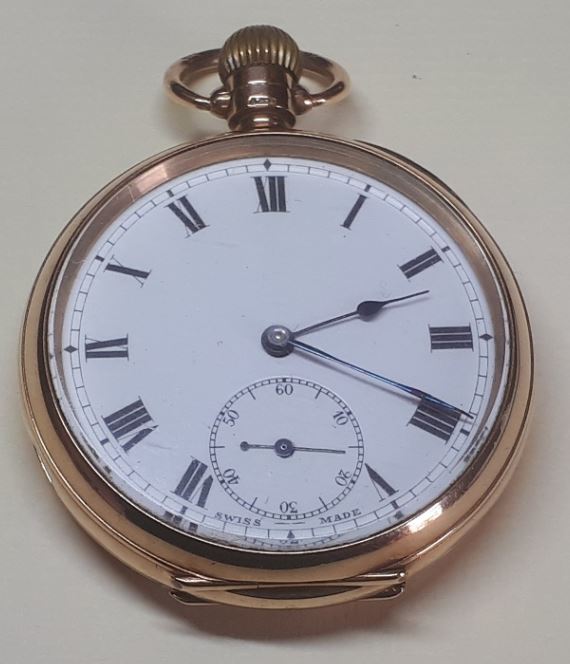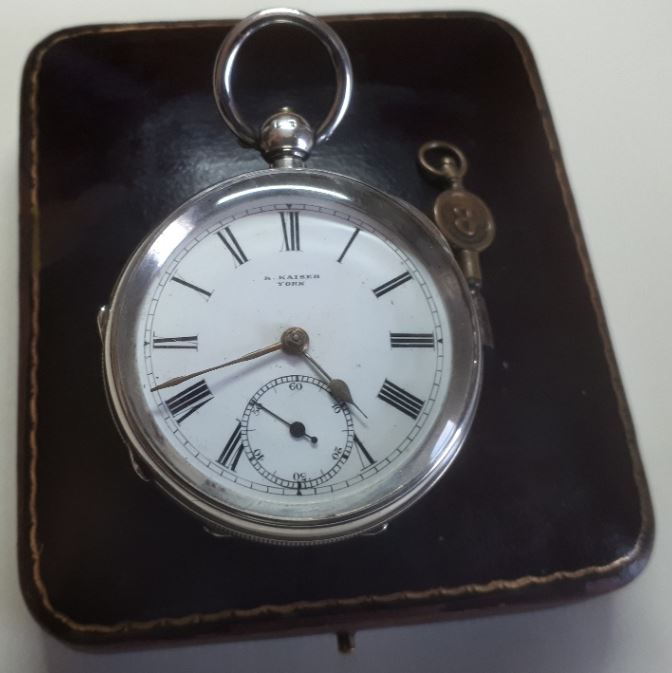Last updated on May 3, 2024
A watch crystal is a clear lens that protects the dial, hands and movement from the elements. A crystal needs to sit high enough above the dial so that the hands are free to move. In a hunter case pocket watch, the lenses are generally thinner to allow the lid to close. It is normally a tight fit so it is important to make sure you don’t close a hunter cased watch from the centre of the case. Closing from the centre of the lid can put pressure on the crystal causing it to crack. Always close a hunter case by pressing from the outer edge of the lid and preserve the latch spring by depressing the crown.
Mineral glass crystals
All antique pocket watches will have originated with a mineral glass crystal. Mineral glass is a hard, scratch-resistant material. However, it is prone to shattering when dropped or chipping when knocked against a hard surface. Acrylic lenses are often found as replacements in antique watches. Acrylic is a plastic that was invented around 1928. Synthetic sapphire was also available from around 1902, but I have not found any antique pocket watches with a lens made from this material, probably due to the expense. However, most high-end modern timepieces have a crystal fashioned from synthetic sapphire crystal. This is because its scratch resistance is really only second to natural diamonds.
Celluloid crystals
The brittle nature of mineral glass proved to be a problem in the trenches of the First World War. The cramped conditions of the trenches, with constant activity and artillery bombardments, were a constant threat to glass lenses in trench watches. One solution was crystals made from bioplastics, such as celluloid and cellulose acetate. These were frequently marketed as ‘unbreakable crystals‘. In fact, these types of crystals actually pre-dated the war. I have seen newspaper advertisements for these unbreakable crystals dating from as early as 1910. Both materials had been available for use since the late 19th century.
Although these bioplastics were much more durable than mineral glass, they did have their own set of problems. Firstly, they lacked the thermostability of glass. This meant they could expand or contract as the temperature changed, causing them to fall out. Secondly, they were highly flammable and will burn explosively if ignited. Cellulose acetate was the slightly less-flammable option. Over time, these crystals decayed becoming brittle and yellowed. Any original bioplastic crystal is likely to have decayed to such a point that it would now be unusable.
Shrapnel guards
Another solution used to protect mineral glass watch crystals in the trenches was the use of shrapnel or mesh guards. These consisted of a metal grill or mesh that covered the watch crystal, but still allowed the time to be read. These were held in place by the wrist strap and had bars or metal domes with holes that allowed the user to read the time through the holes. The thin metal guard would hardly protect a trench watch or its wearer if they were actually hit by shrapnel, a bullet or a shell fired from a field gun. However, it would certainly protect the brittle crystal against the everyday bumps and knocks that it might experience in the cramped conditions of the trenches.
Acrylic crystals
An antique timepiece with an acrylic lens will be a later replacement. Acrylic is softer and more prone to scratching than mineral glass, it is also less likely to shatter than glass. Minor scratches can be polished out using an acrylic polishing compound and a soft cloth. Acrylic is much cheaper than mineral glass and a common replacement. With practice, it is possible to tell the difference by touch and sound. The acrylic will have a softer feel, be warmer to the touch and will have a lower sound when tapping a fingernail against it. An antique pocket watch will generally have a higher value if it still has the original mineral glass crystal. This doesn’t mean that an acrylic lens is less practical for use as a timepiece.
Damaged crystals
It is important to replace a damaged crystal as a crack or break can allow dust and water onto the dial and into the movement. This can age a watch dial and damage the movement. The availability and expense of replacing a damaged mineral glass lens may make the acrylic option a better choice. I have antique pocket watches in my collection that have both types of lenses and for practical purposes, there is no difference.
There are many antique timepieces out there with acrylic lenses. To be honest, I don’t really take the lens material into consideration when making a purchase. Yes, it is always nice to know that you are buying a totally original piece, but I am looking for a presentable and reliable watch. An acrylic lens doesn’t affect the presentability or the reliability of a watch, so I am perfectly happy to purchase an antique timepiece with either type of crystal. As can be seen, by the images above, there is no obvious visible difference between glass and acrylic crystals.
A list of additional posts regarding antique watches can be found on the Guides page.



I read with interest your piece on watch crystals. I have an A.L.D Dennison Moon watch of unknown age. The thing of interest is the crystal, which I had taken to be a replacement as it is unmarked but has that ‘flat’ plastic sound when tapped with a finger nail.
However, the crystal has a distinct yellowish or gold colour cast to it, which is completely uniform and therefore doesn’t seem to be age deterioration. It actually gives the watch a rather pleasant aspect which I find quite pleasing.
Have you come across such a crystal or do you have any thoughts?
Hi Stephen, Dennison was a watch case manufacturer. The Moon grade case was gold filled with layers of 10-carat gold and guaranteed not to wear for 20 years. A different watchmaker will have made the movement. Older types (pre-1950) of acrylic crystals turn yellow as they age because they slowly release nitrogen dioxide and nitric acid. In severe cases, the gases can be trapped between the dial and the crystal causing corrosion of the hands of the watch. I hope this helps, Jason
Hi Jason and thanks for your reply. Luckily there is no evidence of corrosion to the hands. Although the watch has some light scratches to the case, the overall condition is very good. And the dial is perfect. There are tiny numbers scratched by hand inside the back cover which I believe show that the watch has been serviced at least five times. You may also be interested to know that the movement (Swiss Made) is incredibly accurate gaining just two seconds a day over a week. Stephen.
Hi Stephen, Swiss made watches are a favourite of mine, I have had a few in my collection. The accuracy on your watch is very impressive. I have had modern mechanical watches that cannot match that level. I am generally happy if my antique watches are accurate to within one minute per day. Thanks, Jason,